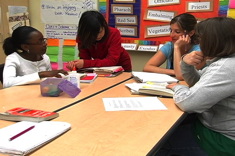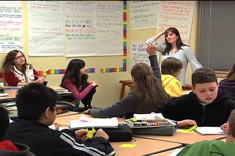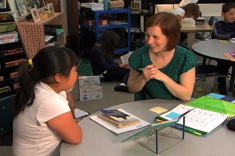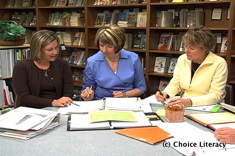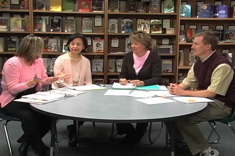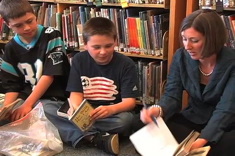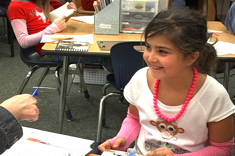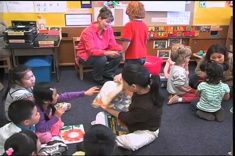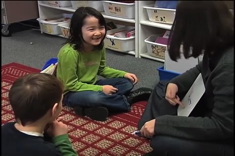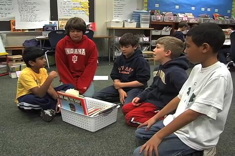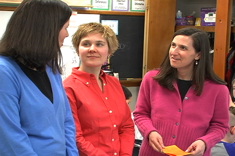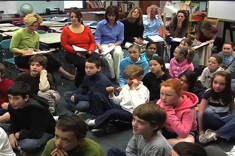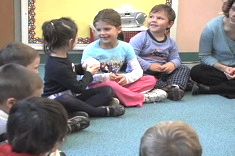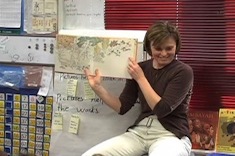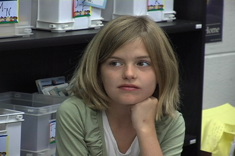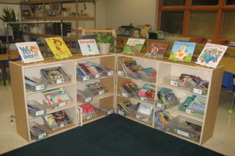Library
Choice Literacy Articles & Videos
The Choice Literacy library contains over 3,000 articles and 900 videos from 150+ contributors. Classic Classroom and Literacy Leadership subscribers have access to the entire library. Content is updated continuously, with five to six new features published each week.
Latest Content
Warm It Up: Lighting a Classroom for Literacy (PHOTO ESSAY)
Here are a few suggestions and quick tips for a lighting redesign from The Sisters (Joan Moser and Gail Boushey).
Beyond Matt Christopher (BOOKLIST)
Franki Sibberson finds many boys who are reluctant readers love the sports novels of Matt Christopher. So what is the logical next author or genre for these boys to keep them reading voraciously?
Literary Nonfiction: Models for Writing
Literary nonfiction is emerging as a popular genre. In this booklist, Franki Sibberson shares mentor texts for writing literary nonfiction.
Whatever Happened to Mrs. Wishy Washy?
Shari Frost notices a neglected tub of big books, and goes on the hunt for shared reading practices among teachers and literacy coaches.
Middle School Readers at Mid-Year (SURVEY TEMPLATE)
Katie Doherty finds surveys of student reading habits and preferences are really useful in the winter, after she knows her students and they’ve settled into a routine.
Weekend Headlines: Whole Class Share
In this final installment of a three-part video series, Katie Doherty and her sixth-grade students continue the Weekend Headlines activity. In this installment, students share their writing with the whole class and respond.
Books That Touch the Heart
Is it ever alright for a teacher to cry when reading aloud? Shari Frost and her colleagues select their favorite tearjerker read alouds, and what they’ve learned from sharing them with students.
Notetaking Series, Part IV: What Counts and Writing the Unwritable
Here are some strategies for getting out of notetaking ruts.
Memorable Moments: Two Quick-Write Closure Activities for End-of-the-Year Study Groups and Staff Meetings (TEMPLATES)
Here are two quick and reflective activities for closure at the end of the year.
Got Space?
Jennifer Allen gets creative with space for displays in her literacy coaching work.
Making Predictions and Finding Evidence in Text
In this video from a fifth-grade small group, Clare Landrigan talks with students about making predictions and finding evidence in text.
Helping Struggling Writers
How can we help students who are stuck when it comes time to write? Franki Sibberson shares a couple new strategies, including a book basket of texts selected by students themselves as useful for sparking writing topics in this photo essay.
Writers on Revision Quote Collection
Our quote collection on revision has many choice quotes for launching study group or class discussions.
Preparing Students for Summer Reading
Franki Sibberson has some great suggestions for jumpstarting students’ summer reading. These ideas work if you are in the last week or two of school, or if you are just beginning a summer enrichment reading program with kids.
Becoming More Purposeful with Writing Share
In this whole-class writing-share session from Katie DiCesare’s first-grade classroom, Katie talks about how she has become more purposeful in connecting student drafts with the minilesson from the start of the writing workshop.
Many Languages, Many Texts: Book Time in Preschool
In this brief video, Melissa Kolb explains "Book Time" in her preschool class. It's a time when many volunteers read books informally to small groups of children in their home languages.
Quotes about Commitment to Teaching
Our quote collection on commitment to teaching includes some provocative quotes for generating discussions about teaching fatigue and renewal.
Learning from the Shadows
Jennifer Allen writes about the power of being shadowed by a young teacher, Jeni, for a full day.
Last Words and Next Steps: Closure Activities for Study Groups and Mentoring Programs
Here are some quick closure activities to help you finish out the last study groups and meetings with colleagues on a high note.
First Grade Small Group: Chunking
In this small group from Courtney Tomfohr's first-grade classroom, students work on their "chunking" skills.
“If You Like Matt Christopher” Student Book Share
In this video from Franki Sibberson’s grades 3-4 classroom, boys share books that are similar to ones written by Matt Christopher.
Quotes about Content Literacy for Adolescents
Here are some just-right quotes for newsletters and opening meetings.
Putting Ourselves in Our Teaching
Debbie Miller's wonderful essay is great to read when you're feeling rushed, and want to hit the "pause button" to remind yourself of what really matters in the classroom.
More Than Listening Centers: Using Audio Books in Literacy Instruction
Shari Frost sorts through the changing world of audio books, and their resurgence in popularity with smaller, cheaper, and trendier MP3 players. She shares some of the innovative ways literacy coaches and teachers in her network are using audio books.
Demonstration Lesson: Inferring Character Traits
In this demonstration lesson from a 5th grade classroom, Clare Landrigan leads students through a reading and discussion of inference and character development.
Morning Meeting in Kindergarten
Danielle French leads her kindergarten students in Waterville, Maine, during morning meeting. After the meeting, Danielle talks with “The Sisters” (Gail Boushey and Joan Moser) about the value of this daily routine.
Envisioning Writing: Wow Words and Mental Images in 1st Grade
In this minilesson, Katie DiCesare uses the book My Cat Copies Me to help her first-grade students “envision” their writing drafts. The lesson focuses on creating mental images to conjure stronger verbs and adjectives while writing.
Favorite Writing Quotes
Quotes to get your creating juices flowing about writing.
Creating a Reflective Culture in Classrooms
Debbie Miller explains how the language we use with students conveys our appreciation for their thinking.
Organizing Book Bins: Letting Kids Help and Plan
Katie DiCesare writes about how children can be enlisted to help in creating and organizing book bins in libraries. But in Katie's classroom, the process of matching books to children begins with "My Stack" – her pile of books that changes daily, linking individual children and texts of interest.
Browse Content By
Type
Category
- Assessment Tools
- Big Fresh Archives
- Booklists
- Choice Numeracy
- Classroom Design
- Common Core
- Community Building
- Conferring
- Content Literacy
- Digital Literacy
- English Language Learners
- Equity
- Family Relations
- Free Samples
- Guiding Groups
- Leadership
- Literacy Coaches
- Mentor Texts
- Minilessons
- New Teacher Mentors
- Podcasts
- Poetry
- Quote Collections
- Reading Strategies
- Self Care
- Struggling and Striving Learners
- Talking and Listening
- Teacher Study Groups
- Teaching Reading
- Teaching Writing
- Word Study and Vocabulary
Author
- Melissa Quimby
- Nawal Qarooni
- Gwen Blumberg
- Julie Cox
- The Lead Learners
- Hannah Tills
- Josie Stewart
- Ruth Metcalfe
- Mallory Messenger
- Becca Burk
- Jodie Bailey
- Vivian Chen
- Mary Brower
- Tiffany Abbott Fuller
- Stephanie Affinito
- Ruth Ayres
- Leigh Anne Eck
- Heather Fisher
- Shari Frost
- Julie Johnson
- Suzy Kaback
- Gigi McAllister
- Shirl McPhillips
- Melanie Meehan
- Cathy Mere
- Debbie Miller
- Tara Barnett and Kate Mills
- Tammy Mulligan
- Dana Murphy
- Bitsy Parks
- David Pittman
- Brenda Power
- Heather Rader
- Matt Renwick
- Mandy Robek
- Christy Rush-Levine
- Gretchen Schroeder
- Jen Schwanke
- Brian Sepe
- Katherine Sokolowski
- Stella Villalba
- Jennifer Vincent
Grade Level
Choice Literacy Membership
Articles
Get full access to all Choice Literacy article content
Videos
Get full access to all Choice Literacy video content
Courses
Access Choice Literacy course curriculum and training





